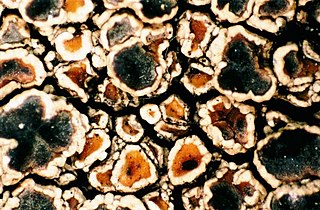
Megasporaceae are a family of fungi belonging to the order Pertusariales. Taxa are lichenized with green algae, and grow on rocks, often in maritime climates close to fresh water. Phylogenetic analysis has shown that this family is related to the Pertusariaceae, another family of lichens. The genus Aspicilia was moved here from the Hymeneliaceae.

The Lecanorales are an order of mostly lichen-forming fungi belonging to the class Lecanoromycetes in the division Ascomycota. The order contains 26 families, 269 genera, and 5695 species.

The Lecanoraceae are a family of lichenized fungi in the order Lecanorales. Species of this family have a widespread distribution.

Lecidella is a genus of crustose lichens in the family Lecanoraceae.
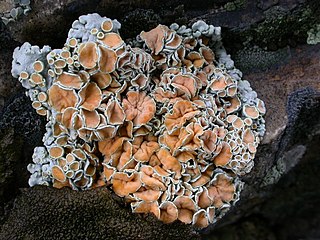
Rhizoplaca is a genus of lichenized fungi in the family Lecanoraceae. Members of the genus are commonly called rimmed navel lichens because of their umbilicate growth form and lecanorine apothecia, also rock-posy lichen and rockbright.
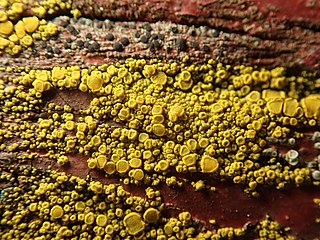
Candelariella is a genus of bright yellow, ocher, or greenish yellow crustose or squamulose lichens in the family Candelariaceae. Members of the genus are commonly called eggyolk lichens, goldspeck lichens, or yolk lichens. The genus was circumscribed in 1894 by Swiss lichenologist Johannes Müller Argoviensis, with Candelariella vitellina assigned as the type species.

Gyalidea is a genus of crustose lichens in the family Gomphillaceae. It has 50 species.
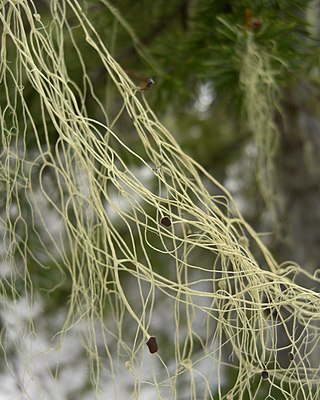
Alectoria is a genus of fruticose lichens belonging to the family Parmeliaceae.

Protoparmeliopsis garovaglii is a species of saxicolous (rock-dwelling), crustose lichen in the family Lecanoraceae. The species was originally described as Placodium garovaglii by German lichenologist Gustav Wilhelm Körber in 1859. It was later classified in Lecanora in 1900, and known as a member of that genus for more than a century. Molecular phylogenetics showed that Lecanora was highly polyphyletic, and as a result, the genus was divided into several smaller, more phylogenetically natural genera. Subsequently, in 2015, Lecanora garovaglii was transferred to genus Protoparmeliopsis.

Lecanora laxa is a species of lichen in the family Lecanoraceae.
Robert "Bob" Shaw Egan is a botanist and lichenologist, specializing in the family Parmeliaceae. He was the president of the American Bryological and Lichenological Society from 1999 to 2001.
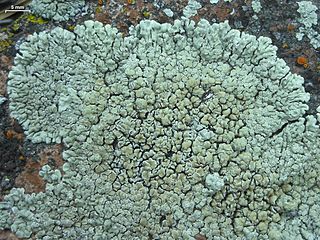
Protoparmeliopsis is a genus of saxicolous (rock-dwelling, crustose lichens in the family Lecanoraceae. It has about 20 species. The genus was circumscribed by French botanist Maurice Choisy in 1929.

Flavoplaca is a genus of crust-like or scaly lichens in the family Teloschistaceae. It has 28 species with a mostly Northern Hemisphere distribution.

Schaereria is a genus of lichen-forming fungi. It is the sole genus in the family Schaereriaceae, which itself is the only family in the Schaereriales, an order in the subclass Ostropomycetidae of the class Lecanoromycetes. Most Schaereria species are crustose lichens that live on rocks. Schaereria was first proposed by Gustav Wilhelm Körber in 1855 and was later taken up by other lichenologists despite periods of disuse.
Lecanora achroa is a species of crustose lichen in the family Lecanoraceae. It was originally described in 1876 by Finnish botanist William Nylander from specimens collected in Rodrigues, Mauritius. The lichen is found in Australia, New Zealand, Papua New Guinea, and North and South America.
Lecanora lichexanthona is a species of crustose and saxicolous (rock-dwelling) lichen in the family Lecanoraceae. Found in Brazil, it was formally described as a new species in 2000 by lichenologist Roland Guderley. The type specimen was collected by Klaus Kalb in a closed cerradão between Rio Verde de Mato Grosso and Coxim where it was found growing on siliceous rock. The specific epithet lichexanthona refers to the presence of the chemical lichexanthone as a major secondary in the lichen. Other compounds in the lichen are atranorin, hybocarpone, constipatic acid, and norlichexanthone. Lecanora lichexanthona is only known to occur in cerradão formations in central Brazil, at altitudes between 500 and 850 m.
Strangospora is a genus of lichen-forming fungi. It is the only genus in the family Strangosporaceae, which itself is of uncertain taxonomic placement in the Ascomycota. It contains 10 species.

Rhizoplaca novomexicana is a species of saxicolous (rock-dwelling), crustose lichen in the family Lecanoraceae. Found in North America, the lichen was first formally described as a new species in 1932 by Adolf Hugo Magnusson, as a member of the genus Lecanora. Sergey Kondratyuk proposed a transfer to the genus Protoparmeliopsis in 2012. Steven Leavitt, Xin Zhao, and H. Thorsten Lumbsch transferred it to the genus Rhizoplaca in 2015, when, following molecular phylogenetics analysis, they emended that genus to include three placodioid species previously placed in Lecanora.














